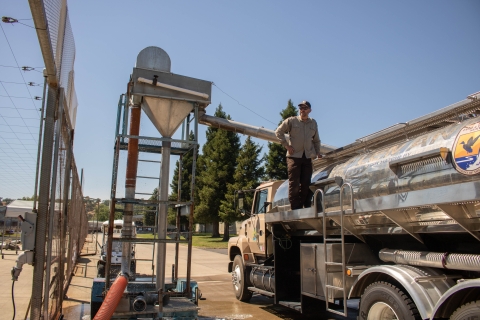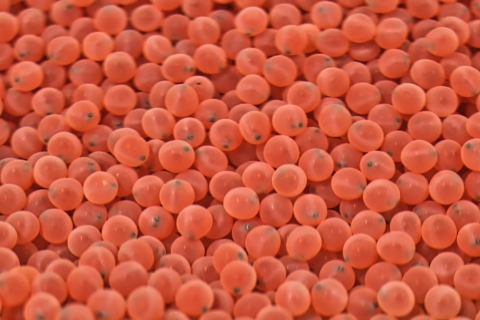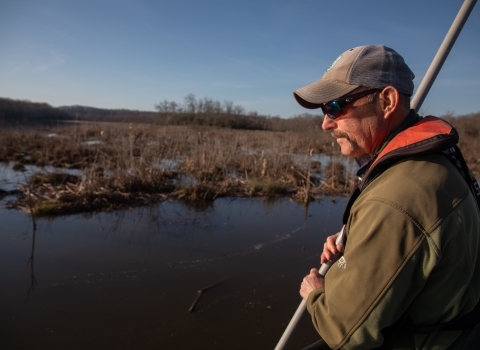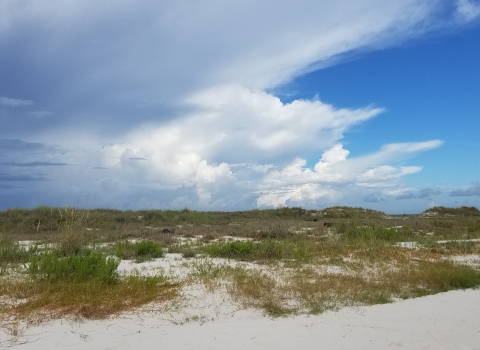When drought comes to California, fish engage in a struggle to survive. Less rain and snow means a drop in water quality, warmer water and less streamflow, leading to increased disease and predation for many species.
At Northern California’s national fish hatcheries, early drought planning and intervention can be the key to survival for millions of juvenile salmon.
“We were talking about [drought response] in January, hoping weather conditions would improve, but developing a game plan in case they didn’t,” said Brett Galyean, project leader for Coleman and Livingston Stone national fish hatcheries. “We were able to release about 11.8 million fall-run Chinook salmon before river conditions turned poor because we planned ahead and used the tools in our toolbox.”
One of those tools was earlier releases. Instead of releasing all of its juvenile fall-run Chinook in April, Coleman released about 6 million in March, when the water was colder, more plentiful and less clear.
Work in previous years has shown that salmon released in March following a rain event are more likely to survive than those released in April without rain — even if the fish released in March are smaller. Storms stir mud and other particles into the water, which provide cover for tiny salmon hiding from predators. Spreading out the timing also means that if one group encounters poor conditions, another might have better luck.
Coleman staff prepared the salmon for early release by giving them plenty of food during rearing to push their growth. By the time Sacramento River conditions became too warm in April, Coleman had already released 92.5% of its fish.
“The hatchery went to extraordinary lengths to rear those fish so they could be released prior to river conditions turning too poor for them to survive their downstream migration,” said Bob Clarke, fisheries program supervisor for the Fish and Wildlife Service’s California-Great Basin Region. “It was a remarkable achievement by our staff and the result of hard work and some fortunate rearing conditions.”
Alternative transportation
Before Coleman releases its fish, the Red Bluff Fish and Wildlife Office evaluates flow and temperature at various points in the Sacramento River. Red Bluff then projects conditions for the three weeks after the proposed release date — the average travel time to navigate the 300 river miles from Coleman’s location on Battle Creek to the Pacific Ocean.
Warm water along that route can make salmon vulnerable to disease and lengthen their travel time, exposing them to more predators. When temperatures got too high for Coleman’s final 951,000 salmon to make that journey in April, the hatchery took the unusual step of giving them a ride down the interstate.
“When you put fish in a truck, there are a lot of different variables that can go wrong — problems with the water temperature or dissolved oxygen levels in the tanks, or even just traffic,” Galyean said, noting the four-hour drive time for this year’s 10 truckloads. “We check on the fish at Red Bluff, about 35 to 40 minutes south of Coleman, and if conditions are poor, we will return the truckload back to the hatchery. Then we check again at two rest stops along the way to monitor the situation and adjust oxygen levels or add ice if we need to.”
Coleman doesn’t normally transport salmon in trucks. The Service’s policy is to release fish at the hatchery because trucked fish are rarely able to find their way back to Battle Creek.
Fall-run Chinook are born in freshwater habitats then travel to the ocean, where they typically live for three years before returning to their birthplace to spawn before dying. Trucked salmon that don’t return to Battle Creek won’t contribute to Coleman’s broodstock broodstock
The reproductively mature adults in a population that breed (or spawn) and produce more individuals (offspring or progeny).
Learn more about broodstock program or the in-river sport fishery, but they will contribute to ocean fisheries.
When Coleman decided to truck salmon this year, the California Department of Fish and Wildlife offered guidance on the location and timing of release. The Department trucks a total of more than 12 million fall-run Chinook from four hatcheries each year, and it trucked nearly 17 million this year because of dry conditions.
“We have looked really closely at previous releases and studied the returns on the coded wire tags [implanted in hatchery fish] from each release site,” said Harry Morse, public information officer for the Department. “We can see which release site, at what point in time, on what tides, had the highest returns… for the last 10 years.”
Coleman chose to release at the Marin Rod & Gun Club in San Rafael, around 9:30 p.m., when predators like seagulls, sea lions and striped bass are less dangerous. Previous years’ releases have shown that predators are not only more active during the day — they will also home in on the agencies’ release sites and schedules if they’re too predictable.
“The main thing is all of us [agencies] working together to get as many fish as possible to the Bay and through the Golden Gate,” Morse said. “We can’t control the ocean conditions, but if we can get them there, that’s our best chance.”
Maximum capacity
At Livingston Stone National Fish Hatchery, less than an hour’s drive north of Coleman, this year’s historic drought changed the game plan for endangered winter-run Chinook salmon, which the hatchery releases each February.
Instead of collecting the hatchery’s usual 120 adult winter-run Chinook in order to raise about 250,000 juveniles, the hatchery is collecting 300 adults with plans to produce 550,000. The increased production is intended to compensate for the projected loss of some eggs and juveniles among the naturally spawning Sacramento River winter-run Chinook population, due to high water temperatures.
Livingston Stone has also been working with the Bureau of Reclamation to install temporary chillers that will cool the hatchery’s water. Preliminary plans to permanently install the tractor-trailer-sized chillers are in the works.
“Reclamation has been very proactive and gone out of their way to get that infrastructure in place,” Galyean said. “It will be hooked up and ready to go by August 1.”
Livingston Stone will operate at peak capacity this fall to accommodate the increased salmon production, with all of its tanks and rearing spaces full. Every one of the critically endangered Chinook raised there will be identified genetically by hatchery staff to ensure genetic purity and prevent inbreeding.
“We do a lot of really fine-scale work, and we have to mobilize a lot of fish-culture talent to pull something like this off,” said Taylor Lipscomb, manager of Livingston Stone. “When we increase production, it increases our workload dramatically, and the staff has to tighten up their boots and get to work… to the staff at the hatchery, this isn’t just a job. It’s about a passion for conservation and a passion for the preservation of species.”







